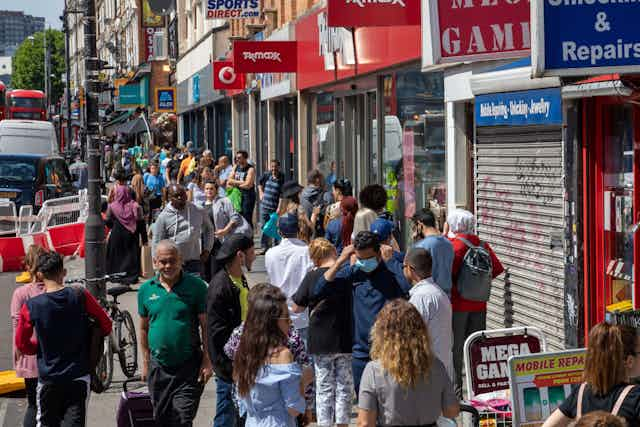When British discount retailer Wilko shut its remaining 68 stores in October 2023, people mourned what they took these closures to signal: the demise of the high street.
The potential or actual decline of England’s town and city centres has long preoccupied community groups, government officials and even artist collectives.
In the 1970s and 1980s, traditional high streets were seen to be struggling to compete with out-of-town shopping centres. More recently, online retail has been blamed. One quarter of UK retail spending now happens online.
The government has devised several policies in response – from the “vital and viable town centres” initiative of 1994 to the “future of our high streets” Portas review of 2011 and, more recently, the Future High Streets Fund, launched in 2018.
The Power to Change charity exists to distribute a £150 million endowment from the National Lottery Community Fund. In 2020, it proposed to fund community improvement districts. These high-street regeneration plans involve community representatives – voluntary organisations, local residents, high street traders and businesses, and public services.
Between 2022 and 2023, we tracked the progress of the first seven community improvement projects. We facilitated eventsand interviewed project leaders and key partners in their local areas. Our report shows trust-building is crucial and that too often, communities feel that regeneration projects are imposed on them, for the benefit of councils and developers.

England’s first seven community improvement districts
Five of the pilots we studied were in Skelmersdale, Lancashire; Hendon, Sunderland; Stretford, Greater Manchester; Wolverton, Milton Keynes, and Ipswich. They each received £20,000 from Power to Change. Two further projects in Kilburn High Road and Wood Green High Road, two busy thoroughfares in North London received an additional £20,000 each from the Greater London Authority.
Some projects, including those in Skelmersdale and Kilburn, were new initiatives. Others, such as Hendon and Wolverton, built on decades of previous activity. The idea was that each would be undertaken with some form of local partnership and that local people would be consulted, through events and meetings, to find out what they wanted in their local high street.
We found that the pilot projects worked best when they managed to encourage this kind of conversation. Members of the public, community-based organisations such as charities and faith groups, local traders and property owners talked to each other and found common ground.

In Kilburn, the London Borough of Camden, which was coordinating the One Kilburn project, employed local residents as so-called “community activators”, to bring local people together. Through these informal conversations, the project team discovered that a particular local concern was the lack of public toilets on Kilburn High Road. They organised a “toilet hackathon”, involving local residents and landowners, including Transport for London, discussing potential solutions.
In Milton Keynes, the project organiser, Future Wolverton (a well established community benefit society), aims to revitalise the town centre alongside a separate scheme to redevelop the site of a demolished 1970s shopping mall. When it had the opportunity to take over the premises of a former charity shop, it used the space to ask residents what they wanted for the town. It also offered opportunities to businesses which couldn’t afford commercial space.
One of the most popular activities it implemented was a repair cafe, where residents could get things fixed and learn how to mend clothes or electrical items. This would not have happened without local people being trusted to come up with ideas.
In Sunderland, meanwhile, the Back on the Map charity – what is known as a “community anchor organisation” with a 20-year track record of local grassroots activity – worked with the council. The charity proposed to arrange for vouchers issued by the council to support people suffering hardship to be valid in local shops. This, it argued, would support local traders who were also struggling because of the cost-of-living crisis.
Here, the project focused on Villette Road, in Hendon: a neighbourhood high street that had a reputation for crime and was blighted with shuttered shops. One of the initiatives, that wasn’t expensive but sent a strong signal to the community, was to installation the street’s first Christmas tree for almost a century. The charity also put up signs branding the street as the “heart of Hendon”. As one member of the project team* put it:
Having the street branded and have somebody care about the street again, it made the traders come together as a collective with a shared vision rather than just having individual conversations where it was just moaning about things, it turned it around to a more positive conversation.

Research shows regeneration needs to respect and build on people’s attachments to the places they live and work in. Local people need to have the sense that decision-makers are listening to their concerns.
Expensive capital and real estate-led projects often fail to do this. Instead, they tend to rely on private developers, who invest in places in return for profit and do not yield the regeneration they promise. This has been demonstrated by the reported debacle of the Hackney Walk fashion hub in east London. Here, the £100m luxury redevelopment of a suite of railway arches saw local businesses evicted to make way for big-name fashion brands, which, in the absence of the promised footfall that brought them there, have all since closed down.
Hackney Walk is, as journalist Simon Usborne puts it, an example of exactly “what not to do”. It is too early to know whether the seven projects we’ve worked on will yield better long-term economic and social impacts. What is clear, however, is that in involving communities on an equal basis, they are starting from a better place. People need to have their say in decisions made about where they live.
*All our interviewees’ names are withheld for anonymity

